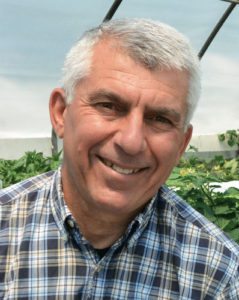Greenhouse and Nursery Sanitation: An Obsessive Compulsive Commitment
Who among us suffers from obsessive compulsive disorder (OCD)? I do. My hand tools are arranged by size in dedicated tool drawers. The two switches of a three-way light circuit (top and bottom of stairs) both need to be pointing down when the light is off (shoot me an email after you think about that one). And don’t get me started on how to handle a half-used tube of toothpaste.

Considering sanitation practices around greenhouses and nurseries, we repeatedly hear from plant pathologists that, in so many words, being obsessive and compulsive is precisely the set of skills required to succeed. But instead of submitting to the stigma of a “disorder,” why not describe it more inclusively as a commitment? We should take pride in practicing an obsessive compulsive commitment (OCC, you heard it here first) to sanitation in our greenhouses and nurseries.
Joining me is Judy McWhorter from Pace 49. Judy has served our industry for many years with a focus on greenhouse and nursery sanitation, irrigation water enhancement and surfactant use. I’ve been working on a project with her and Pace 49 for two years investigating a new generation quaternary ammonium product containing the active ingredient DDAC. We’ve been researching its use in irrigation systems for algae, biofilm and plant pathogen control.
Peter: Judy, our work together involves microbial contamination in various settings and situations. Please explain the challenge growers face regarding these microbes and how they affect crop production.

Judy: Peter, in order to answer this question, we first have to distinguish between hard surfaces, irrigation lines and irrigation water enhancement. Is our focus algae control on concrete floors, flood tray surfaces and greenhouse sidewalls? Is it biofilm growth inside irrigation lines reducing water flow and providing algae a safe haven? Is it plant pathogens being spread throughout an operation via its recirculating irrigation system?
Growers understand that all three of these areas must be targeted when it comes to microbial contamination and crop quality. But I observe too many trying to strike these “three birds” with a single stone. More often than not the easiest and/or cheapest approach will not address all three areas effectively.
Peter: So we as educators need to do a better job is what I’m hearing. If too many growers are looking for the easy solution, a “magic bullet,” then we need to improve both the message and the messengers’ approach.
Judy: Yes, both concerns, debunking the magic bullet approach and explaining the differences between the three target areas (hard surfaces, irrigation lines and recirculating water) must be addressed before I can talk about which product to use in which area. Additionally, I emphasize that a continuous effort aimed at prevention reduces the overall cost of the sanitation practices about to be discussed. Your obsessive compulsive commitment statement is spot on in this regard.
Peter: Okay, understanding these three distinct targets lays a foundation for us. Let’s add another layer of complexity, one that you have brought to my attention. You routinely visit growing operations around the country and Canada and observe differences between greenhouse irrigation systems and their nursery counterparts. The differences are important when treatment strategies are developed. Please explain.
Judy: Greenhouse operations use significantly more liquid fertilizer injection, whereas nurseries rely more on fertilizer incorporation into the growing medium coupled with clear water irrigation. I observe more mineral deposition in greenhouse lines that is often also associated with a higher level of algae and biofilm due to the injected nitrogen and other nutrients.
The mineral buildup is much more difficult to clean out and requires a three step cleaning program. We recommend injection of an acid detergent as step one to dissolve the build up in irrigation lines and nozzles. In our experiences, disinfectants alone can come up a bit short. This detergent treatment must be thoroughly rinsed, which is step two. Once the lines and nozzles are clean residual control is achieved with injection of a quaternary ammonia disinfectant as step three. This process defines our ACBD system: Always Clean Before Disinfecting.
Nurseries can usually get by with only two steps because the initial mineral and microbial contamination level can be lower in the absence of fertilizer injection. Generally, a disinfectant alone can be used to clean nursery lines followed by a rinse.
Peter: Thank you for that observation. How have your recommendations for the two types of operations evolved when it comes to microbial contamination management?
Judy: Regardless of the type of horticultural operation, this area of microbial contamination is ever present and requires a watchful eye. I see no avoidance of having to address these challenges of algae, water borne plant pathogens and biofilm in any horticultural operation. But as we’re discussing, certain settings and situations require more aggressive treatment.
Cleaning and disinfecting irrigation lines is important for several reasons. First, two of these microbe groups, algae and biofilm, have evolved to the point where they flourish in each other’s presence. So together they become more of a problem than if they were alone. I have had growers ship me sections of their irrigation pipes that are so fouled by this algae-biofilm complex that water flow through the pipe is reduced dramatically. Last year I sent you one of these PVC pipe sections so you could do some testing with our products.
Peter: I recall that it came from a nursery on the East Coast. I took some fascinating pictures showing the complex layering of bacterial growth embedded with algae and other material. Pictures of the inside of that pipe before and after treatment are included in my irrigation management presentations. That brings to mind another difference between greenhouses and nurseries. Nurseries often deal with larger volumes of irrigation water — larger diameter pipes, higher flow rates, overhead sprinklers.
The PVC pipe section sent to me had a layer of biofilm that was a quarter inch thick reducing the inside diameter from 1.5 to 1.0 inches. That ring of contamination reduced the cross sectional area by more than 50 percent, which reduces flow significantly. Essentially, the 1.5-inch lines were performing as 1 inch.
Judy: Another reason for cleaning and disinfecting irrigation lines is to control the introduction and spread of plant pathogens that cause disease problems. It has been documented that biofilm is a great place for pathogens like Pythium to hide and rear their ugly heads when conditions are favorable. So removing the biofilm will help reduce disease problems caused by water borne pathogens such as Pythium and Phytophthora and reduce the spread of pathogens such as Xanthomonas.
Peter: During our shared presentations at recent grower conferences you spent time distinguishing between cleaning and disinfecting. Today’s discussion includes another acronym, one that you and Pace 49 created years ago … ACBD. You introduced it above, please define and describe this concept and how the puzzle pieces fit together.
Judy: As I mentioned, ACBD is Always Clean Before Disinfecting. Let’s return to the magic bullet concept that so many growers hope is effective. In my experience, using only a disinfectant on a dirty surface is not a safe bet. Depending on the degree of microbial and mineral fouling either on a hard surface or inside an irrigation line, much more disinfectant is needed to attack the microbial load. Often, the level of treatment required becomes either cost prohibitive or not effective enough to justify the higher rate.
We developed the ACBD system to reduce the amount of disinfectant needed by first eliminating as much of the deposits as we can through a lower cost cleaning step.
We describe cleaning as using a detergent to remove debris and some biofilm and mineral deposits from hard surfaces and irrigation lines. The debris and dirt removed by the detergent are rinsed away leaving a clean or cleaner surface for the disinfectant to be applied to.
Peter: DDAC was mentioned above. How is this new generation quat chemistry different from its predecessors?
Judy: DDAC is an improved formulation over the older quaternary ammonias with regard to worker and crop safety and performance. It provides longer residual activity at 30 days compared to 14 for older quats. This generation of quat is safer for workers to use and less phytotoxic to crops. Lower use rates also separate it from earlier quat generations and DDAC is recommended for use in hydroponic systems.
Peter, a final comment emphasizes how the two of us agree regarding the magic bullet approach. Pace 49 recently acquired Selectrocide chlorine dioxide as a complementary product in our product line. Expanding into this category of sanitation chemistry will allow us to work with organic growers as it is OMRI certified.
So, there’s no single magic bullet out there that’s going to solve everything. We need to have several tools in our sanitation tool boxes and understand when and how to use them. Rather than one bullet let’s think of a sanitation arsenal.
Peter: Thank you Judy, we covered much ground in this conversation and agree that ongoing research and education will continue to advance our knowledge base. As we all move forward together I hope more growers will feel a sense of pride in stating that they practice an obsessive compulsive commitment to greenhouse and nursery sanitation.


 Video Library
Video Library 




















